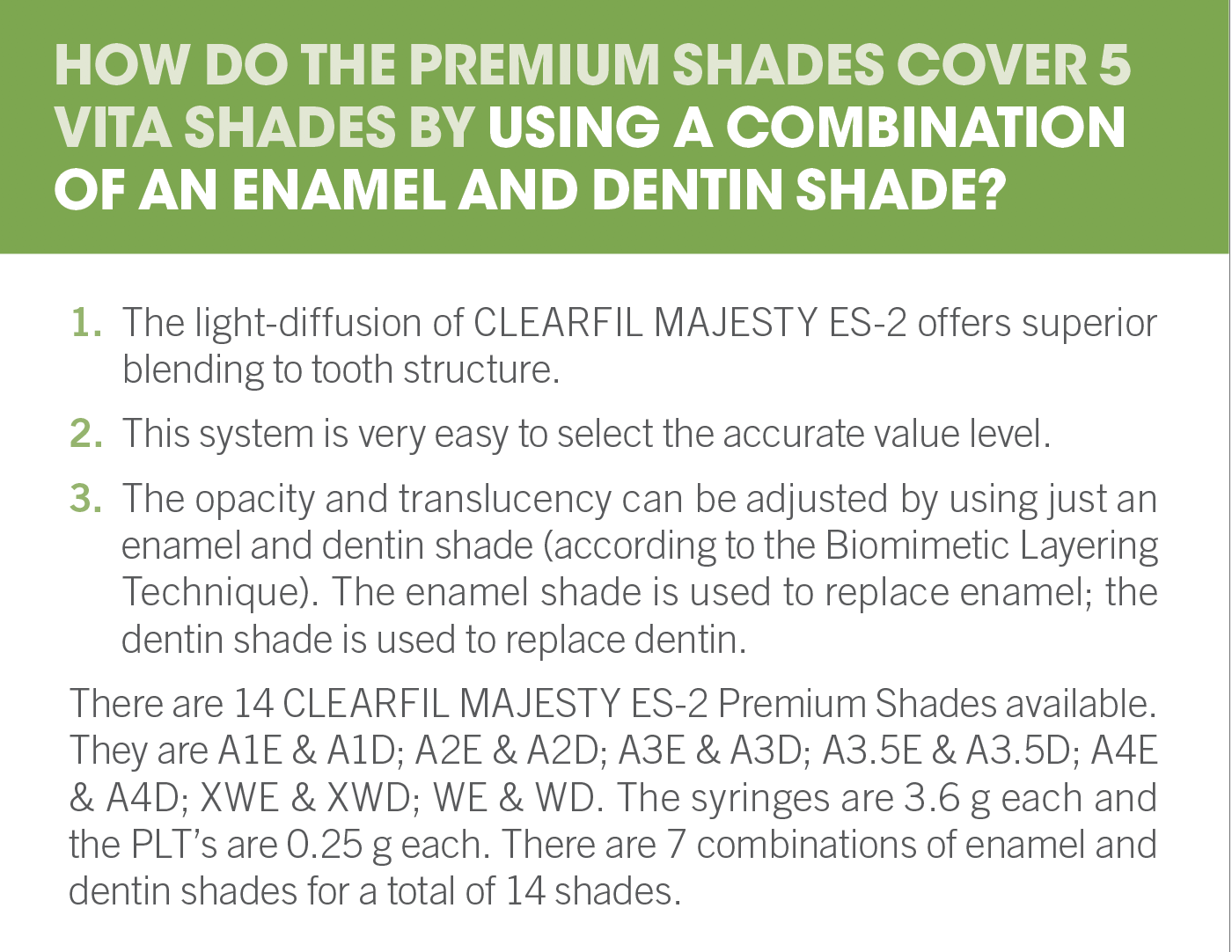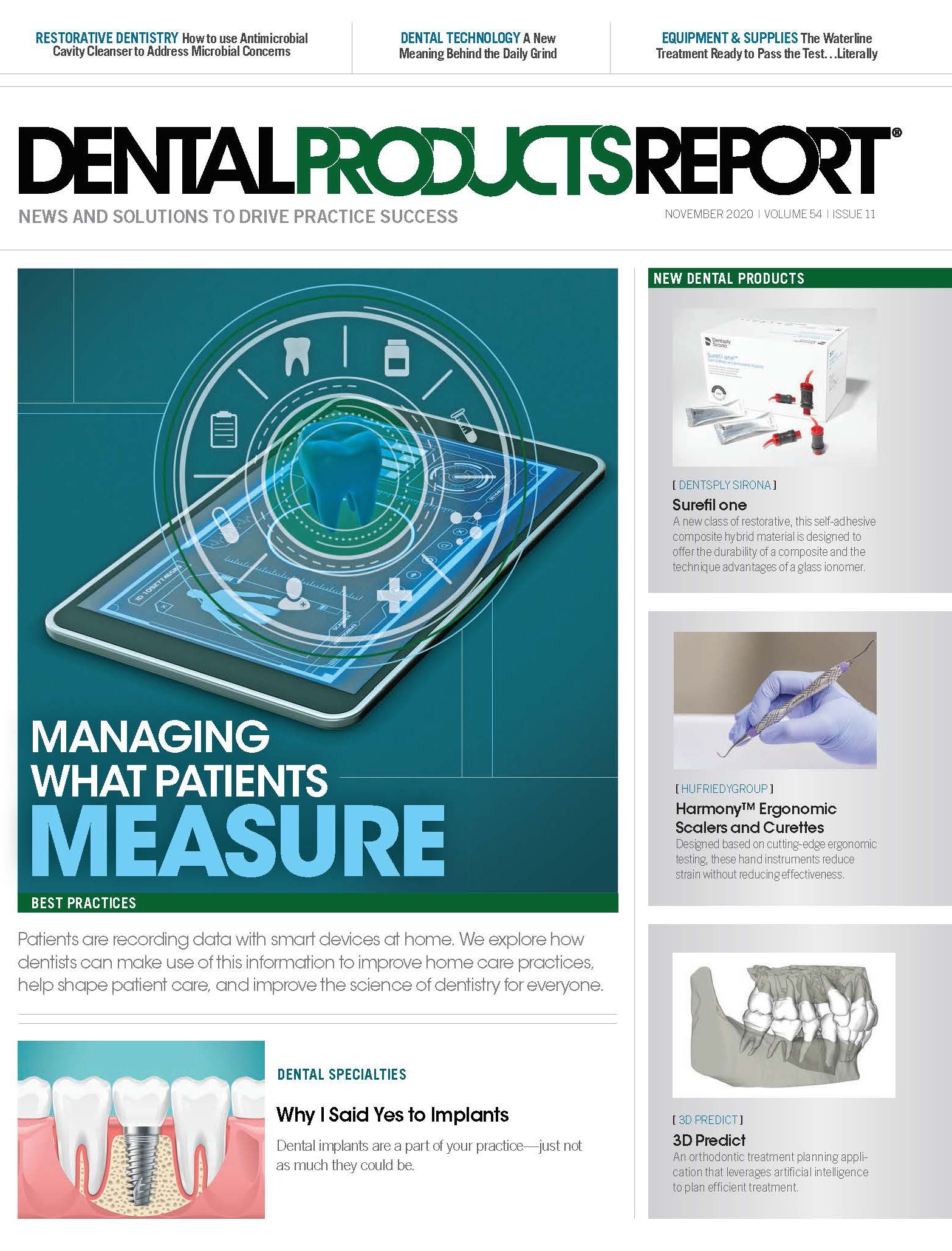A 40-year-old female patient presented with a primary concern of desiring a more harmonious smile and requested the most conservative treatment protocol possible. She was particularly unhappy with the small size of her maxillary laterals, teeth Nos. 7 and 10, in relation to her central incisors, Nos. 8 and 9. Composite buildups were completed on these teeth several years earlier by a different clinician to address the patient’s concerns with her peg laterals. However, she was not completely satisfied with the results, which was her motivation to have them redone.
CLEARFIL MAJESTY ES-2 Premium composite
- Only composite with a VITA-approved shade concept
- Single shade placement technique due to light-diffusion technology
- Long working time for easy sculpting with no slumping
- Light diffusion property similar to natural teeth
- Easy polishing with durable gloss
- Virtually no post-cure color change
Kuraray Noritake
800-879-1676 | kuraraydental.com
Clinical Objective
The clinical objective of the case was a conservative smile rejuvenation. Because the patient worked for a dental company that manufactures composites, she was well-versed in the different treatment choices available to her and very insistent on the most unobtrusive treatment possible.
Treatment Plan
Instead of doing porcelain veneers that might have required some removal of healthy tooth structure, we chose additive dentistry with composite buildups. Although the actual case was a treatment of 4 teeth (Nos. 7-10), this article focuses on treating No. 7 in particular. We treated the 2 central incisors with Kuraray Noritake’s CLEARFIL MAJESTY™ ES-2 Premium composite, shade A1 only. We treated the laterals with 2 shades of CLEARFIL MAJESTY ES-2 Premium composite: B1 enamel on the lingual and the facial, and A1 dentin between those 2 layers.
Technique
The preoperative photo shows the 2 central incisors with tooth No. 9 slightly more prominent in the facial aspect than No. 8 (Figure 1).
We used a conservative facial buildup using a single composite shade to correct that, creating a uniform and balanced appearance of tooth Nos. 8 and 9. After removing the old layers of composite buildup on the facial surface of the 2 peg laterals (tooth Nos. 7 and 10), we lightly roughened the enamel surface as well.
Using a Brasseler USA® fine diamond bur, approximately 0.25 mm of tooth structure was removed at the gingival margins of tooth Nos. 7 and 10 to provide a definitive gingival margin (Figure 2). Once we prepared the laterals for composite buildup, we placed a retraction cord around the gingival margin. Again, this case will focus on tooth No. 7, as the treatment protocol for tooth No. 10 was the same.
We placed polytetrafluoroethylene (PTFE) tape on the adjacent teeth, and 35% phosphoric acid etchant liberally applied onto the facial of tooth No. 7 (Figure 3). After 30 seconds, we rinsed the etch off, removed the PTFE tape, and placed CLEARFIL SE PROTECT BOND on the facial (Figure 4). Next, we placed putty on the lingual to allow an anatomical build-up of composite on the lingual shelf (Figure 5). We based the build-up upon a lab wax-up of the 4 anterior teeth. To accomplish the build-up, the composite was placed in the stent and pushed up on the lingual of tooth No. 7, to allow the composite to flow into the desired facial shape and length. We then light cured the composite with the stent in place.
We confirmed the correct incisal length once the stent was removed, based on the incisal edge of the wax-up and stent. We then used an Almore International instrument to place the A1 dentin shade of composite on the facial surface (Figure 6), and a CompoSculp instrument from HuFriedyGroup to place mamelons in the dentin layer of the incisal edge.
Because the patient had hypocalcification or white spots on her adjacent teeth, we used a small artist brush to add white tint to the incisal third of the dentin layer (Figure 7), which was then light cured. Next, we placed and smoothed a layer of B1 enamel with a sable brush to get the correct approximate shape (Figure 8). We then light cured the layer again.
We first used the polishing protocol flame-shaped fine diamond from Brasseler to get the general contour, then progress through a series of discs starting with a medium setting and ending with a fine setting to get a more definitive shape, contour, and initial polish. Lastly, using a goat-hair wheel, we applied polishing pastes in 3 progressively smaller grain sizes to achieve a high luster final polish (Figure 9).
Conclusion
This case’s results were 4 extremely conservative composite build-up restorations that involved the removal of virtually no healthy tooth structure; only old composite. Then the patient was very pleased with the new esthetic results including improved shape and a natural shade that matched her neighboring teeth.
We chose Kuraray Noritake’s CLEARFIL MAJESTY ES-2 flowable and premium composite because of the ease of handling, proven long-term record of success in clinical application, and its ease of polishability



